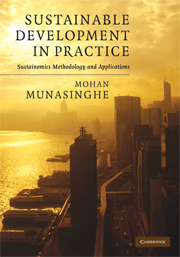Book contents
- Frontmatter
- Contents
- Foreword by James Gustave Speth
- Preface
- Part I Framework and fundamentals
- 1 Overview and summary
- 2 Sustainomics framework
- 3 Economics of the environment
- 4 Ecological and social aspects
- Part II Global and transnational applications
- Part III National and macroeconomic applications
- Part IV Sub-national sectoral and system applications
- Part V Project and local applications
- References
- Index
2 - Sustainomics framework
Published online by Cambridge University Press: 05 August 2012
- Frontmatter
- Contents
- Foreword by James Gustave Speth
- Preface
- Part I Framework and fundamentals
- 1 Overview and summary
- 2 Sustainomics framework
- 3 Economics of the environment
- 4 Ecological and social aspects
- Part II Global and transnational applications
- Part III National and macroeconomic applications
- Part IV Sub-national sectoral and system applications
- Part V Project and local applications
- References
- Index
Summary
In this chapter, the elements of the sustainomics framework are set out in greater detail. Section 2.1 describes the fundamental principles and methods. Sustainable development, traditional development and growth are defined. A practical approach based on making development more sustainable, or MDMS, is described as an alternative to pursuing abstract definitions of sustainable development. The sustainable development triangle (comprising social, economic and environmental dimensions) is introduced, and the driving forces and concepts of sustainability underlying each viewpoint are explained. Sustainomics also promotes methods which transcend conventional boundaries of thinking and full-cycle analysis from data gathering to practical policy implementation. In Section 2.2, the dimensions of the sustainable development triangle, their interactions and different concepts of sustainability are explained. Methods for integrating these three dimensions are described in Section 2.3, including the complementary concepts of optimality and durability. The poverty–equity–population–natural-resources nexus, and linkages between economic efficiency and social equity, are discussed. Section 2.4 describes a variety of practical methods and tools for applying sustainomics principles to the real world, including the Action Impact Matrix, sustainable development assessment, cost–benefit analysis, multicriteria analysis and so on. It is important to select relevant time- and location-specific indicators of sustainable development. Section 2.5 outlines approaches for restructuring long-term growth and development to make them more sustainable by harmonizing development with nature, while pursuing poverty reduction in developing countries that require continued growth of incomes and consumption.
Information
- Type
- Chapter
- Information
- Sustainable Development in PracticeSustainomics Methodology and Applications, pp. 31 - 71Publisher: Cambridge University PressPrint publication year: 2009
